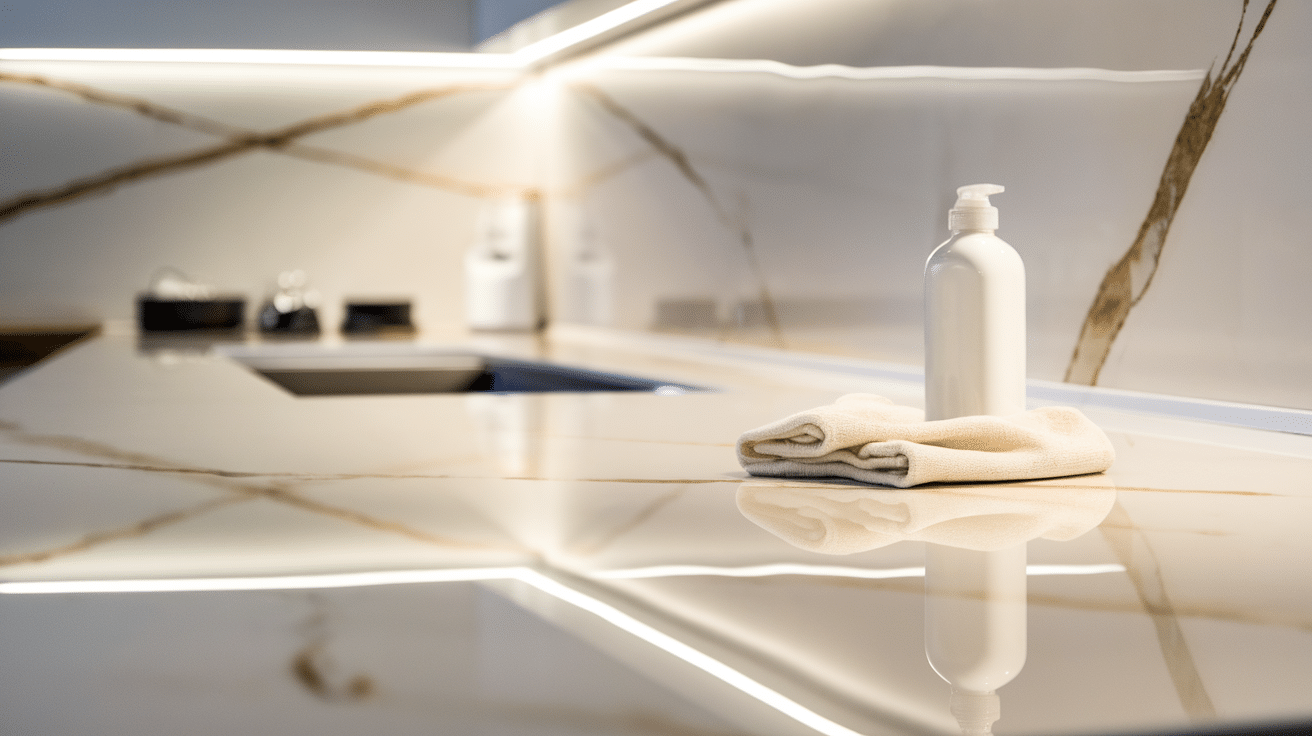Do you worry about damaging your beautiful quartzite countertops with the wrong cleaning products?
You’re not alone. Many homeowners struggle with knowing how to clean quartzite properly without causing permanent damage to their expensive stone surfaces.
Using harsh chemicals or abrasive cleaners can etch, scratch, or dull your quartzite, leaving you with costly repairs.
The good news is that learning how to clean quartzite correctly is simpler than you think. With the proper methods and products, you can keep your countertops looking pristine for years.
This article will walk you through everything you need to know about quartzite cleaning.
You’ll learn daily cleaning routines, stain removal techniques, proper maintenance schedules, and what to avoid to prevent damage.
By the end, you’ll confidently care for your quartzite countertops like a pro.
What is Quartzite?
Quartzite is a natural stone made from sandstone and quartz. Heat and pressure deep in the earth create this hard material over millions of years.
This natural process makes quartzite one of the hardest stones you can use in your home. It’s harder than granite and marble.
Many people confuse quartzite and quartz, but they are distinct materials. Quartzite is a 100% natural stone that forms in nature. Quartz countertops are man-made from ground quartz and resins.
Quartzite requires sealing to protect it from stains, whereas quartz countertops don’t. When you want to clean quartzite, you need different methods than cleaning quartz surfaces.
How to Clean Quartzite Countertops
We all know how beautiful quartzite countertops can be, but keeping them that way often feels like a delicate balancing act.
The wrong cleaner can ruin the shine, and even simple spills can leave stains. But with the right approach, you can keep your quartzite surfaces stunning and long-lasting. Here’s how.
1. Daily Cleaning
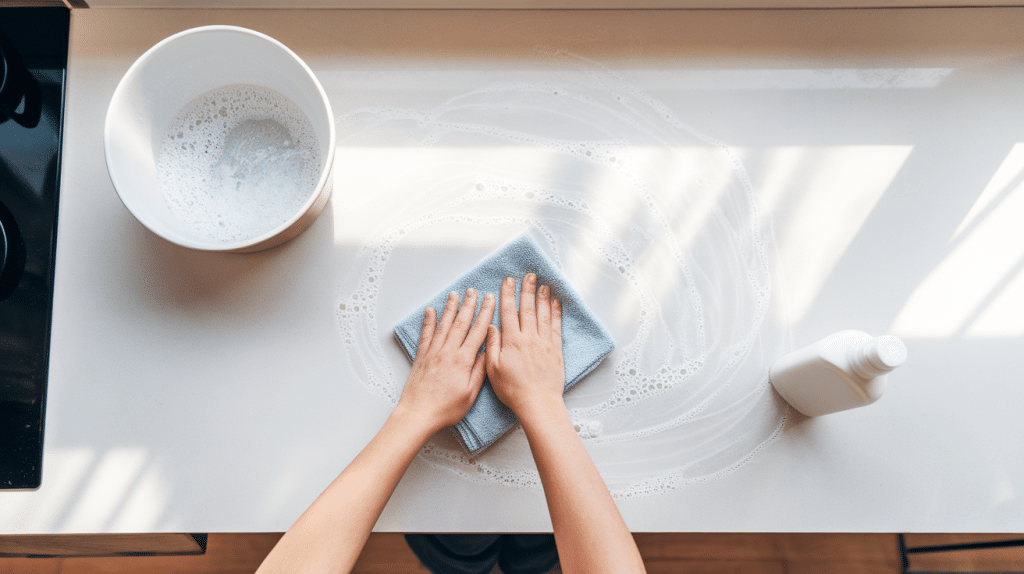
Start your daily quartzite cleaning routine with simple supplies. You need warm water, mild dish soap, and a soft microfiber cloth. Avoid paper towels as they can scratch the surface.
First, remove all items from your countertop. Wipe away any crumbs or debris with a dry cloth. Fill a bowl with warm water and add just a few drops of mild dish soap. Mix gently to create light suds.
Dip your microfiber cloth in the soapy water and wring it out well. The cloth should be damp, not soaking wet. Wipe the entire quartzite surface using circular motions. Pay extra attention to areas around the sink and stove where buildup occurs.
Rinse your cloth with clean water and wipe the surface again to remove soap residue. Dry the countertop completely with a clean, dry microfiber cloth. This prevents water spots and keeps your quartzite looking shiny.
2. Deep Cleaning
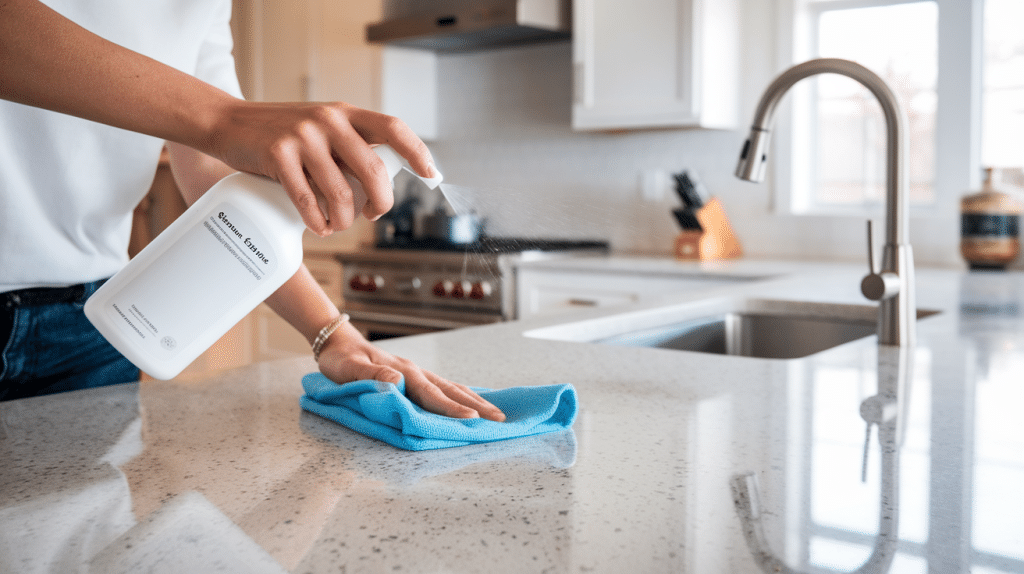
Deep clean your quartzite once a week or when you notice buildup. You’ll need a stone-safe cleaner made specifically for natural stone surfaces. Never use regular household cleaners for this step.
Remove everything from your countertops and sweep away loose debris. Spray the stone-safe cleaner across the entire surface. Let it sit for 2-3 minutes to break down grease and residue.
Use a soft cloth or sponge to work the cleaner in circular motions. Focus on areas with visible buildup or stains. For stubborn spots, let the cleaner sit a bit longer before wiping.
Rinse thoroughly with clean water to remove all cleaner residue. Dry completely with a soft towel. Your quartzite should look fresh and clean after this deep cleaning process.
3. Disinfecting
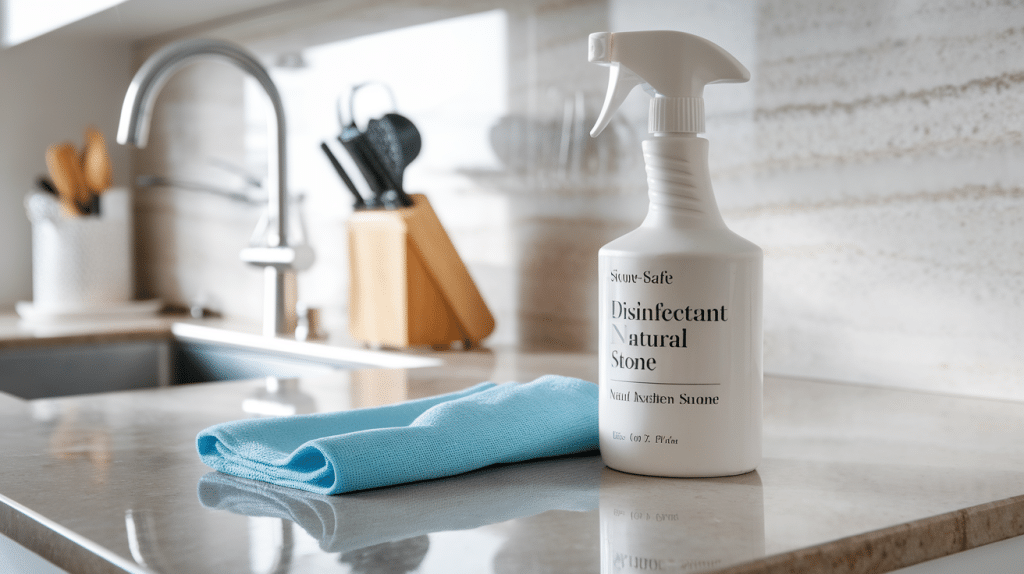
Disinfecting your quartzite countertops is an essential step, especially in high-use areas like kitchens.
While daily cleaning removes dirt and debris, disinfecting helps kill bacteria, germs, and viruses, offering an extra layer of protection. However, it’s crucial to use the right products to prevent any damage to the stone’s surface or sealant.
For effective and safe disinfection, always use a stone-safe disinfectant specifically formulated for natural stone.
Carefully read the product label to confirm its compatibility with quartzite.
While a daily wipe-down with mild soap and water offers general cleanliness, a purpose-built disinfectant provides the necessary microbial kill for thorough sanitization.
To disinfect:
- Use a clean microfiber cloth or sponge.
- Dip it in the soapy water or disinfectant solution and gently wipe the countertop, focusing on high-touch areas like around the sink and stove.
- Allow the surface to air dry to ensure proper disinfection. If using a stone-safe disinfectant, follow the manufacturer’s instructions for application and drying time.
4. Polishing
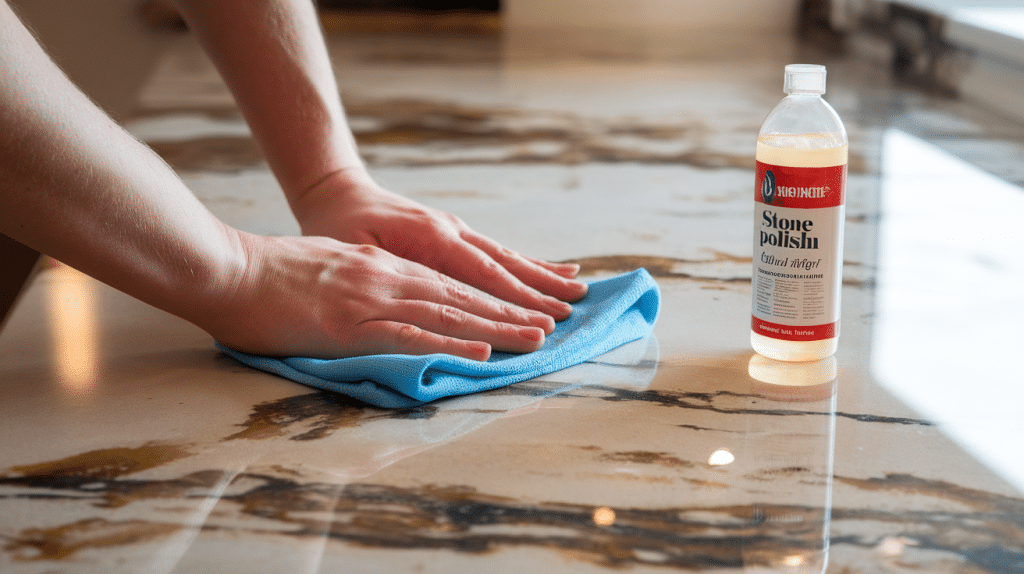
Polish your quartzite monthly to maintain its natural shine. Use only polish made specifically for natural stone. Regular furniture polish or glass cleaners will damage the surface.
Start with a completely clean and dry countertop. Apply a small amount of stone polish to a soft cloth. Work in small sections, applying the polish in circular motions.
Buff the surface with a clean, dry microfiber cloth until you achieve the desired shine. The polish should enhance the natural beauty of your quartzite without leaving streaks or residue.
Some quartzite surfaces may not need regular polishing. Check with your stone supplier to understand your specific quartzite needs.
Quartzite Cleaning Do’s and Don’ts
Proper care is essential for maintaining your quartzite countertops. In this section, we’ll cover the essential do’s and don’ts to ensure your surfaces stay pristine, avoid common mistakes, and protect the stone from damage.
| DO’s | DON’ts |
|---|---|
| Use cutting boards for all food prep | Place hot pots directly on the countertop |
| Use trivets or heat pads under hot cookware | Use abrasive cleaners like scouring powder |
| Clean spills immediately to prevent stains | Use steel wool or rough scrubbing pads |
| Wipe surfaces dry with microfiber cloths | Use Windex or glass cleaners regularly |
| Test sealant yearly with water drops | Drag heavy items across the surface |
| Reseal every 1-2 years as needed | Use generic “granite” cleaners from stores |
| Call professionals for deep stains or cracks | Let acidic spills sit on the surface |
| Use stone-safe disinfectants when needed | Skip daily cleaning and maintenance |
Maintenance Tips for A Clean Quartzite
1. Handle Stains Quickly: Blot spills immediately with a clean cloth. Don’t rub the stain deeper into the stone. Clean with warm water and stone-safe soap.
2. Use Poultices for Stubborn Stains: Mix baking soda with water to make a thick paste. Spread over the stain, cover with plastic wrap, and leave for 24 hours. Remove and rinse clean.
3. Test Your Sealant Regularly: Drop water on the surface. If it beads up, the sealant is good. If it soaks in within 10 minutes, reseal your quartzite.
4. Follow Daily Prevention Rules: Use cutting boards for food prep. Clean daily with mild soap and water. Dry completely to prevent water spots.
5. Protect from Heat and Scratches: Always use trivets under hot pots and pans. Lift heavy items instead of dragging them across the surface to prevent scratches.
When Is Quartzite Cleaning Not Enough?
Call a stone care professional if you see etching, deep stains, or cracks in your quartzite. These problems need expert attention to be fixed properly.
DIY repairs can often make the damage worse. Professional stone care experts have special tools and products for quartzite repair. They can restore your countertops to their original beauty. This service is often more affordable than replacing damaged stone.
Small chips and scratches can sometimes be polished out by professionals. They use special compounds and tools to smooth the stone surface. This process requires skill and experience to do correctly.
Deep cracks may need filling with a stone repair compound. This work should only be done by experienced stone care professionals. They can match the repair material to your stone’s color and finish.
Etching from acidic spills can often be polished out if caught early. Professional restoration can bring back the stone’s original shine and smoothness.
Final Thoughts
Learning how to clean quartzite doesn’t have to be complicated. With the simple methods outlined in this article, you can maintain the beauty of your countertops and protect your investment.
Remember the key points: use pH-balanced cleaners, clean spills immediately, and test your sealant regularly.
The most important thing is consistency. Daily cleaning with warm water and mild soap helps prevent most problems before they start.
When you do encounter stains or damage, don’t hesitate to call professionals rather than risk making things worse.
Your quartzite countertops can look stunning for decades with proper care.
Start implementing these cleaning methods today, and you’ll enjoy beautiful, durable surfaces that add value to your home.
With the right knowledge and routine, keeping your quartzite in perfect condition becomes second nature.

